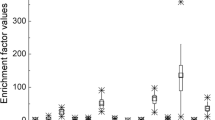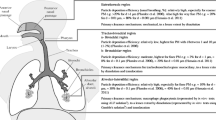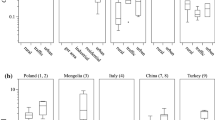Abstract
Bioavailability of environmental contaminants is attracting considerable scientific attention due to growing awareness of its importance for risk assessment. In this study, size-segregated airborne particles were collected from six point-source sites, an urban residential site, and a sub-urban site. Potential factors governing bioaccessibility of the particle-bound polycyclic aromatic hydrocarbons (PAHs) and organophosphorus esters (OPEs) in stimulated gastrointestinal and respiratory tracts were elucidated. Particle concentrations of PAHs and OPEs at the eight sites were 2.4-32.3 ng/m3 and 1.6-19.9 ng/m3, respectively. In fine particles (with aerodynamic diameter less than 2.5 μm), 4- to 6-ring PAHs were more strongly correlated with organic carbon (OC) than elemental carbon (EC); while 3- and 4-ring PAHs in coarse particles (2.5-10 μm) tended to associate with EC. OPEs mostly showed significant correlations with EC in both fine and coarse particles. OC and EC exerted a significantly restraining effect on the oral and inhalation bioaccessibility of most hydrophobic organic contaminants (HOCs) in fine particles due to sorption of HOC molecules to these components. Furthermore, the effects varied, which could depend either on the emission sources (for oral bioaccessibility of PAHs) or the physicochemical properties of HOCs (for bioaccessibility of OPEs and inhalation bioaccessibility of PAHs). Linear regression between OC/EC contents and HOC bioaccessibility indicated that EC should play a more important role in the inhalation bioaccessibility than the oral bioaccessibility. Particle size of airborne particles is a relatively less significant factor determining the bioaccessibility.



Similar content being viewed by others
References
Castro Jimenez J, Gonzalez Gaya B, Pizarro M, Casal P, Pizarro Alvarez C, Dachs J (2016) Organophosphate ester flame retardants and plasticizers in the global oceanic atmosphere. Environ Sci Technol 50:12831–12839. https://doi.org/10.1021/acs.est.6b04344
Cui XY, Xiang P, He RW, Juhasz A, Ma LQ (2016) Advances in in vitro methods to evaluate oral bioaccessibility of PAHs and PBDEs in environmental matrices. Chemosphere 150:378–389. https://doi.org/10.1016/j.chemosphere.2016.02.041
Doherty BT, Hammel SC, Daniels JL, Stapleton HM, Hoffman K (2019) Organophosphate esters: are these flame retardants and plasticizers affecting children’s health? Curr Environ Health Rep 6:201–213. https://doi.org/10.1007/s40572-019-00258-0
Duan L, Palanisami T, Liu Y, Dong Z, Mallavarapu M, Kuchel T, Semple KT, Naidu R (2014) Effects of ageing and soil properties on the oral bioavailability of benzo[a]pyrene using a swine model. Environ Int 70:192–202. https://doi.org/10.1016/j.envint.2014.05.017
Fang ML, Stapleton HM (2014) Evaluating the bioaccessibility of flame retardants in house dust using an in vitro Tenax bead-assisted sorptive physiologically based method. Environ Sci Technol 48:13323–13330. https://doi.org/10.1021/es503918m
Gao P, Hu J, Song J, Chen X, Ou C, Wang H, Sha C, Hang J, Xing B (2019) Inhalation bioaccessibility of polycyclic aromatic hydrocarbons in heavy PM2.5 pollution days: implications for public health risk assessment in northern China. Environ Pollut 255:113296. https://doi.org/10.1016/j.envpol.2019.113296
Guan W-J, Zheng X-Y, Chung KF, Zhong N-S (2016) Impact of air pollution on the burden of chronic respiratory diseases in China: time for urgent action. Lancet 388:1939–1951. https://doi.org/10.1016/S0140-6736(16)31597-5
Guney M, Chapuis RP, Zagury GJ (2016) Lung bioaccessibility of contaminants in particulate matter of geological origin. Environ Sci Pollut R 23:1–13. https://doi.org/10.1007/s11356-016-6623-3
Guo TF, Lin T, Li YY, Wu ZL, Jiang YQ, Guo ZG (2019) Occurrence, gas-particle partitioning, and sources of polybrominated diphenyl ethers in the atmosphere over the Yangtze River Estuary, East China Sea. Sci Total Environ 693. https://doi.org/10.1016/j.scitotenv.2019.07.344
He RW, Li YZ, Xiang P, Li C, Zhou CY, Zhang SJ, Cui XY, Ma LQ (2016) Organophosphorus flame retardants and phthalate esters in indoor dust from different microenvironments: bioaccessibility and risk assessment. Chemosphere 150:528–535. https://doi.org/10.1016/j.chemosphere.2015.10.087
He RW, Li YZ, Xiang P, Li C, Cui XY, Ma LQ (2018) Impact of particle size on distribution and human exposure of flame retardants in indoor dust. Environ Res 162:166–172. https://doi.org/10.1016/j.envres.2017.12.014
Hou R, Xu Y, Wang Z (2016) Review of OPFRs in animals and humans: absorption, bioaccumulation, metabolism, and internal exposure research. Chemosphere 153:78–90. https://doi.org/10.1016/j.chemosphere.2016.03.003
Huang H, Jiang Y, Xu XY, Cao XD (2018) In vitro bioaccessibility and health risk assessment of heavy metals in atmospheric particulate matters from three different functional areas of Shanghai, China. Sci Total Environ 610:546–554. https://doi.org/10.1016/j.scitotenv.2017.08.074
Jonker MT (2016) Determining octanol–water partition coefficients for extremely hydrophobic chemicals by combining “slow stirring” and solid-phase microextraction. Environ Toxicol Chem 35:1371–1377. https://doi.org/10.1002/etc.3300
Juhasz AL, Tang W, Smith E (2016) Using in vitro bioaccessibility to refine estimates of human exposure to PAHs via incidental soil ingestion. Environ Res 145:145–153. https://doi.org/10.1016/j.envres.2015.12.001
Kademoglou K, Giovanoulis G, Palm Cousins A, Padilla Sanchez JA, Magner J, de Wit CA, Collin CD (2018) In vitro inhalation bioaccessibility of phthalate esters and alternative plasticizers present in indoor dust using artificial lung fluids. Environ Sci Tech Let 5:329–334. https://doi.org/10.1021/acs.estlett.8b00113
Kang Y, Man YB, Cheung KC, Wong MH (2012) Risk assessment of human exposure to bioaccessible phthalate esters via indoor dust around the Pearl River Delta. Environ Sci Technol 46:8422–8430. https://doi.org/10.1021/es300379v
Kim KH, Kabir E, Kabir S (2015) A review on the human health impact of airborne particulate matter. Environ Int 74:136–143. https://doi.org/10.1016/j.envint.2014.10.005
La Guardia MJ, Hale RC (2015) Halogenated flame-retardant concentrations in settled dust, respirable and inhalable particulates and polyurethane foam at gymnastic training facilities and residences. Environ Int 79:106–114. https://doi.org/10.1016/j.envint.2015.02.014
Li WH, Wang Y, Kannan K (2019a) Occurrence, distribution and human exposure to 20 organophosphate esters in air, soil, pine needles, river water, and dust samples collected around an airport in New York state, United States. Environ Int 131:105054. https://doi.org/10.1016/j.envint.2019.105054
Li Y, Juhasz AL, Ma LQ, Cui X (2019b) Inhalation bioaccessibility of PAHs in PM2.5: Implications for risk assessment and toxicity prediction. Sci Total Environ 650:56–64. https://doi.org/10.1016/j.scitotenv.2018.08.246
Liu R, He R, Cui X, Ma LQ (2018) Impact of particle size on distribution, bioaccessibility, and cytotoxicity of polycyclic aromatic hydrocarbons in indoor dust. J Hazard Mater 357:341–347. https://doi.org/10.1016/j.jhazmat.2018.05.058
Liu X, Ji R, Shi Y, Wang F, Chen W (2019) Release of polycyclic aromatic hydrocarbons from biochar fine particles in simulated lung fluids: implications for bioavailability and risks of airborne aromatics. Sci Total Environ 655:1159–1168. https://doi.org/10.1016/j.scitotenv.2018.11.294
Lohmann R, Lammel G (2004) Adsorptive and absorptive contributions to the gas-particle partitioning of polycyclic aromatic hydrocarbons: state of knowledge and recommended parametrization for modeling. Environ Sci Technol 38:3793–3803. https://doi.org/10.1021/es035337q
Marcoccia M, Ronci L, De Matthaeis E, Setini A, Perrino C, Canepari S (2017) In-vivo assesment of the genotoxic and oxidative stress effects of particulate matter on Echinogammarus veneris. Chemosphere 173:124–134. https://doi.org/10.1016/j.chemosphere.2017.01.019
Niu J, Rasmussen PE, Hassan NM, Vincent R (2010) Concentration distribution and bioaccessibility of trace elements in nano and fine urban airborne particulate matter: influence of particle size. Water Air Soil Pollut 213:211–225. https://doi.org/10.1007/s11270-010-0379-z
Oleszczuk P, Godlewska P, Reible DD, Kraska P (2017) Bioaccessibility of polycyclic aromatic hydrocarbons in activated carbon or biochar amended vegetated (Salix viminalis) soil. Environ Pollut 227:406–413. https://doi.org/10.1016/j.envpol.2017.04.064
Peterson BS, Rauh VA, Bansal R, Hao X, Toth Z, Nati G, Walsh K, Miller RL, Arias F, Semanek D (2015) Effects of prenatal exposure to air pollutants (polycyclic aromatic hydrocarbons) on the development of brain white matter, cognition, and behavior in later childhood. Jama Psychiat 72:531–540. https://doi.org/10.1001/jamapsychiatry.2015.57
Polachova A, Gramblicka T, Parizek O, Sram RJ, Stupak M, Hajslova J, Pulkrabova J (2020) Estimation of human exposure to polycyclic aromatic hydrocarbons (PAHs) based on the dietary and outdoor atmospheric monitoring in the Czech Republic. Environ Res 182. https://doi.org/10.1016/j.envres.2019.108977
Raffy G, Mercier F, Glorennec P, Mandin C, Le Bot B (2018) Oral bioaccessibility of semi-volatile organic compounds (SVOCs) in settled dust: a review of measurement methods, data and influencing factors. J Hazard Mater 352:215–227. https://doi.org/10.1016/j.jhazmat.2018.03.035
Rajagopalan S, Al Kindi SG, Brook RD (2018) Air pollution and cardiovascular disease JACC state-of-the-art review. J Am Coll Cardiol 72:2054–2070. https://doi.org/10.1016/j.jacc.2018.07.099
Ruby MV, Lowney YW, Bunge AL, Roberts SM, Gomez Eyles JL, Ghosh U, Kissel JC, Tomlinson P, Menzie C (2016) Oral bioavailability, bioaccessibility, and dermal absorption of PAHs from soil-state of the science. Environ Sci Technol 50:2151–2164. https://doi.org/10.1021/acs.est.5b04110
Salgueiro Gonzalez N, De Alda ML, Muniategui Lorenzo S, Prada Rodriguez D, Barcelo D (2015) Analysis and occurrence of endocrine-disrupting chemicals in airborne particles. Trac-Trends Anal Chem 66:45–52. https://doi.org/10.1016/j.trac.2014.11.006
Samara C, Voutsa D, Kouras A, Eleftheriadis K, Maggos T, Saraga D, Petrakakis M (2014) Organic and elemental carbon associated to PM10 and PM2.5 at urban sites of northern Greece. Environ Sci Pollut R 21:1769–1785. https://doi.org/10.1007/s11356-013-2052-8
Semple KT, Riding MJ, McAllister LE, Sopena Vazquez F, Bending GD (2013) Impact of black carbon on the bioaccessibility of organic contaminants in soil. J Hazard Mater 261:808–816. https://doi.org/10.1016/j.jhazmat.2013.03.032
Shen M, Xing J, Ji Q, Li Z, Wang Y, Zhao H, Wang Q, Wang T, Yu L, Zhang X (2018) Declining pulmonary function in populations with long-term exposure to polycyclic aromatic hydrocarbons-enriched PM2.5. Environ Sci Technol 52:6610–6616. https://doi.org/10.1021/acs.est.8b00686
Shen H, Li W, Graham SE, Starr JM (2019) The role of soil and house dust physicochemical properties in determining the post ingestion bioaccessibility of sorbed polychlorinated biphenyls. Chemosphere 217:1–8. https://doi.org/10.1016/j.chemosphere.2018.10.195
Siciliano SD, Laird B, Lemieux C (2010) Polycyclic aromatic hydrocarbons are enriched but bioaccessibility reduced in brownfield soils adhered to human hands. Chemosphere 80:1101–1108. https://doi.org/10.1016/j.chemosphere.2010.04.061
Sofowote UM, McCarry BE, Marvin CH (2008) Source apportionment of PAH in Hamilton Harbour suspended sediments: comparison of two factor analysis methods. Environ Sci Technol 42:6007–6014. https://doi.org/10.1021/es800219z
Sun SJ, Jia LR, Li B, Yuan AN, Kong LJ, Qi H, Ma WL, Zhang AP, Wu YN (2018) The occurrence and fate of PAHs over multiple years in a wastewater treatment plant of Harbin, Northeast China. Sci Total Environ 624:491–498. https://doi.org/10.1016/j.scitotenv.2017.12.029
Thorsen WA, Cope WG, Shea D (2004) Bioavailability of PAHs: effects of soot carbon and PAH source. Environ Sci Technol 38:2029–2037. https://doi.org/10.1021/es0306056
Wang J, Chen SJ, Tian M, Zheng XB, Gonzales L, Ohura T, Mai BX, Simonich SLM (2012) Inhalation cancer risk associated with exposure to complex polycyclic aromatic hydrocarbon mixtures in an electronic waste and urban area in South China. Environ Sci Technol 46:9745–9752. https://doi.org/10.1021/es302272a
Wang W, Wu FY, Huang MJ, Kang Y, Cheung KC, Wong MH (2013a) Size fraction effect on phthalate esters accumulation, bioaccessibility and in vitro cytotoxicity of indoor/outdoor dust, and risk assessment of human exposure. J Hazard Mater 261:753–762. https://doi.org/10.1016/j.jhazmat.2013.04.039
Wang W, Wu FY, Zheng JS, Wong MH (2013b) Risk assessments of PAHs and Hg exposure via settled house dust and street dust, linking with their correlations in human hair. J Hazard Mater 263:627–637. https://doi.org/10.1016/j.jhazmat.2013.10.023
Wang C, Wu S, Zhou S, Wang H, Li B, Chen H, Yu Y, Shi Y (2015) Polycyclic aromatic hydrocarbons in soils from urban to rural areas in Nanjing: concentration, source, spatial distribution, and potential human health risk. Sci Total Environ 527-528:375–383. https://doi.org/10.1016/j.scitotenv.2015.05.025
Wang X, Zhu QQ, Yan XT, Wang YW, Liao CY, Jiang GB (2020) A review of organophosphate flame retardants and plasticizers in the environment: analysis, occurrence and risk assessment. Sci Total Environ 731:139071. https://doi.org/10.1016/j.scitotenv.2020.139071
Werner D, Hale SE, Ghosh U, Luthy RG (2010) Polychlorinated biphenyl sorption and availability in field-contaminated sediments. Environ Sci Technol 44:2809–2815. https://doi.org/10.1021/es902325t
Xie SY, Lao JY, Wu CC, Bao LJ, Zeng EY (2018) In vitro inhalation bioaccessibility for particle-bound hydrophobic organic chemicals: method development, effects of particle size and hydrophobicity, and risk assessment. Environ Int 120:295–303. https://doi.org/10.1016/j.envint.2018.08.015
Yu YX, Yang D, Wang XX, Huang NB, Zhang XY, Zhang DP, Fu JM (2013) Factors influencing on the bioaccessibility of polybrominated diphenyl ethers in size-specific dust from air conditioner filters. Chemosphere 93:2603–2611. https://doi.org/10.1016/j.chemosphere.2013.09.085
Yu YX, Jiang ZA, Zhao ZS, Chong D, Li GY, Ma ST, Zhang YN, An TC (2018) Novel in vitro method for measuring the mass fraction of bioaccessible atmospheric polycyclic aromatic hydrocarbons using simulated human lung fluids. Environ Pollut 242:1633–1641. https://doi.org/10.1016/j.envpol.2018.07.114
Zeng Y, Fan Y, Yan X, Zheng J, Chen SJ, Mai BX (2019) In vitro oral and inhalation bioaccessibility of hydrophobic organic contaminants (HOCs) in airborne particles and influence of relevant parameters. Environ Res 170:134–140. https://doi.org/10.1016/j.envres.2018.12.025
Zhang YY, Pignatello JJ, Tao S, Xing BS (2015) Bioaccessibility of PAHs in fuel soot assessed by an in vitro digestive model with absorptive sink: effect of food ingestion. Environ Sci Technol 49:14641–14648. https://doi.org/10.1021/acs.est.5b04342
Acknowledgements
The authors thank Jia-Cheng Li from South China Normal University for his help in the field work and the reviewers for their valuable comments and suggestions.
Availability of data and materials
All data generated or analyzed during this study are included in this published article and its supplementary information files.
Funding
This study was financially supported by the National Key R&D Program of China (2017YFC0212000), the Guangzhou Science and Technology Program (No. 201707020033), the National Science Foundation of China (Nos. 41771530 and 41573088), the Guangdong Foundation for Program of Science and Technology Research (No. 2017B030314057), and the State Key Laboratory of Organic Geochemistry, GIGCAS (NO. SKLOG202001).
Author information
Authors and Affiliations
Contributions
All authors contributed to the study conception and design. Investigation, writing—original draft, formal analysis, and methodology: YZ; conceptualization, writing—review and editing, and supervision: SJC; investigation: YF and QQL; supervision: BXM. All authors read and approved the final manuscript.
Corresponding author
Ethics declarations
Ethics approval and consent to participate
Not applicable.
Consent for publication
Not applicable.
Competing interests
The authors declare no competing interests.
Additional information
Responsible Editor: Gerhard Lammel
Publisher’s note
Springer Nature remains neutral with regard to jurisdictional claims in published maps and institutional affiliations.
Supplementary Information
ESM1
(DOCX 2221 kb).
Rights and permissions
About this article
Cite this article
Zeng, Y., Chen, S., Fan, Y. et al. Effects of carbonaceous materials and particle size on oral and inhalation bioaccessibility of PAHs and OPEs in airborne particles. Environ Sci Pollut Res 28, 62133–62141 (2021). https://doi.org/10.1007/s11356-021-14848-9
Received:
Accepted:
Published:
Issue Date:
DOI: https://doi.org/10.1007/s11356-021-14848-9




